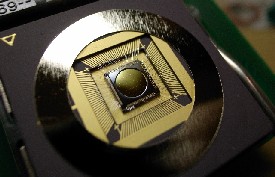Earlier this week astronomers reported observation of the smallest known planet orbiting a star other than our own. Indeed we now know about 300 such “exoplanets”, most of which are gas giants like Jupiter. Now, a new imaging technique using optical fibres could help planet-hunters towards an astronomer’s holy grail – direct observation and characterization of an Earth-like planet.
The problem with detecting such planets is one of resolution - light coming from them is incredibly faint compared with light from the parent star. A team of researchers from France and Australia suggest overcoming this problem, by feeding light through single-mode optical fibres from the telecomm industry. The new technique significantly improves the resolution of existing adaptive optics (AO), a method for reducing image fuzziness of astronomical images, say the researchers.
“Planet-hunters have started to specialize in recent years; like predators in an ecosystem,” says Peter Tuthill, one of the researchers, from the University of Sydney. “In the long run, we are aiming to characterize and study the planets themselves, not just stamp-collect them in discovery catalogues.”
Exoplanet suite
Astronomers first began detecting exoplanets back in the late 1980s, but since then detection methods have changed surprisingly little. The majority of these discoveries have resulted from two methods: either looking for a star’s “wobble” caused by the gravity of a planet as it orbits; or looking for the dimming of a star as an orbiting planet sweeps in front and partially-blocks the starlight.
In the long run, we are aiming to characterize and study the planets themselves, not just stamp-collect them in discovery catalogues. Peter Tuthill, University of Sydney
Whilst these techniques can reveal the orbits and masses of the exoplanets, they can tell us very little about the atmosphere of planets within a solar system’s “habitable zone”. Although space-borne telescopes bypass image-blurring of the Earth’s atmosphere, it is still very difficult to resolve planetary light from that of its much brighter parent star. Contrasts are typically one in 100 million for a Jupiter-sized planet and one in 10 billion for an earth-sized one.
Despite these difficulties, two separate teams of astronomers, last November, did finally report the first “bona fide” direct images of exoplanets. They utilized the wide 8-10 m apertures of the Gemini and Peck earthbound telescopes. They also employed an imaging technique known as adaptive optics (AO) to “clear up” the images. AO telescopes work by including a flexible primary mirror which can be calibrated - using light from bright “guiding stars” near the astronomers’ target zone – to improve the resolution of images.
“AO’s main advantage is that it removes the effect of phase aberrations, seen as ‘speckles’, via spatial filtering and careful mapping” says Christian Marois of the Herzberg Institute of Astrophysics in Canada. One of the drawbacks of AO, however, is that calibration is notoriously difficult due to its high dependence on the angular separation between star and planet.
Adaptive Optics fine tuned
With this latest research, Tuthill and colleagues make calibration easier through developing an established technique known as “aperture masking”. In standard aperture masking, light is passed through small holes which causes the beams to diffract; observers then infer the presence – or non presence – of exoplanets from the resulting interference pattern. Until now, however, this technique has been hampered by imperfections in the interferometry equipment.
The researchers have improved aperture masking by placing an array of 36 single mode optical fibers behind the aperture disk. By feeding incoming light through the fibres the wavefronts retain their relative phases, leading to an improved resolution and reliability of data (arXiv:0901.2165 ). “You can think of aperture masking as an afterburner for an AO system because we will still use an AO system to do the first-pass at correcting the starlight for aberrations” said Tuthill.
Although the ‘pupil remapping’ approach is yet to be tested on real astronomical images Tuthill told physicsworld.com that the technology is “hot off the development bench” in the photonics industry.
Community reaction
Wesley Traub, Chief Scientist for the NASA Navigator Program, told physicsworld.com, “The new method is similar to pupil masking, but different in that all of the pupil can now be used.”
“The really interesting new feature is that they use phase closure to look for a non-symmetric distribution of light on the sky, as would be produced by a star with a planet nearby,” he added.
Tuthill and his colleagues now plan to test their device on real images of space. “In the longer term, we hope there might be potential for the next generation of giant telescopes,” he said. “As yet nobody knows how to build the AO systems to make these giants function properly, but our team thinks that instruments like the ones described here will be a key component to getting the best science from the new generation of behemoth telescopes.”
Adaptive optics expert Denis Brousseau of Laval University in Canada told physicsworld.com, “The technique holds the potential to improve aperture masking at major world observatories.”











